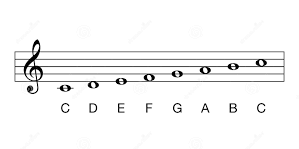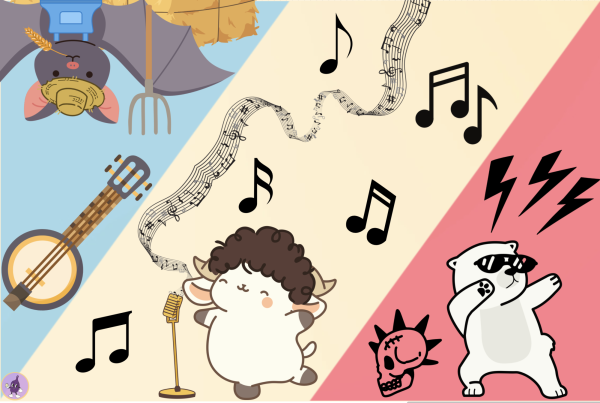THE INTERVALS IN MUSIC
And What songs to help identify them

C major scale in treble clef
Intervals are labeled based on the distance between two notes. Simple intervals only follow one octave and are counted by the half steps between notes. Music intervals can either be ascending or descending. Ascending means the second note is higher than the first note and descending meaning the second note will be lower than the previous note. We can use well known songs to help identify ascending and descending intervals just by ear. Referring to a major C scale, I will go through each interval’s name and song that ties to it. There are also two youtube playlists with all of the songs listed in order of intervals for reference.
A common way
-MUSICCA
to identify intervals
by ear is to
associate them
with songs or
so-called interval
reference songs.
Ascending Intervals:
Unison- Starting on C if the following note is also C then it will be unison. There is no change of tone making the note a repeat of the first. Unison is very easy to recognize in songs, for instance in Happy Birthday, the first two notes are the same.
Minor 2nd’s- The next interval is a minor 2nd. If the starting note is C and the note after is D♭ that would be a half step between. A great song that repeats minor 2nd’s is The Jaws Theme. Isn’t She Lovely by Stevie Wonder is also another song that uses minor 2nd’s.
Major 2nd’s- Now if the change is one whole step between it would be a major 2nd. Continuing with the C scale, the first note would be C and the following note would be a D. Ignoring the repeat of the G in Happy Birthday, the note after is A which is a major 2nd. The childhood song Frere Jacques is also a good identification for major 2nd’s.
Minor 3rd’s- Minor 3rd’s would be 3 half steps apart. C to E♭ is a minor 3rd on the major C scale. The piece, Brahms’ Lullaby and the song Jingle bells have minor 3rd’s at the start of them.
Major 3rd’s- C to E is a major 3rd. These intervals will be 2 whole steps apart from each other. The first two notes in It’s A Small World are a major 3rd. The Minecraft song Wet hands the melody starts as a major 3rd.
4th’s- 4th’s are special. They can be perfect which means that the sound frequencies and their ratios are whole numbers. Perfect 4th’s will be 5 steps apart, C to F. The iconic wedding song, Bridal Chorus is a good example for 4th’s along with Amazing Grace.
Tritones- A tritone is 3 whole steps apart, C to G♭. This is harder to spot in music but the best song example is the first two notes in the Simpsons theme.
Perfect 5th’s- 5th’s are easier to spot in music. They will be 7 half steps apart, C to G. The classic Star Wars Theme and Twinkle Twinkle Little Star have perfect 5th’s in the beginning.
Minor 6th’s – Minor 6th intervals are 4 whole steps apart, from C to A♭. These intervals can be difficult to hear, yet a good example of minor 6th’s is the first two notes of Entertainer.
Major 6th’s- Major 6th’s are 9 half steps apart from each other, C to A. Using Jingle Bells again, when the song say’s “Dashing Through the Snow,” The first two notes of that phrase are major 6th’s.
Minor 7th’s- Notes that are 5 whole steps apart are minor 7th’s With the major C scale, a minor 7th’s would be C to B♭. The best example of minor 7th’s in music would be the Star Trek theme.
Major 7th’s- C to B are 11 half steps apart from each other. The hit 80’s song Take On Me, When he sings the chorus, “Take on me” that jump is a major 7th.
Octaves- These are special intervals because they are the same note. However the second note is an octave above which is 6 whole notes apart. With the major C scale it would be C to C. We can hear this jump in Somewhere Over The Rainbow, When Judy Garland sings “Some-where”. An Octave is also present in the beginning of When You Wish Upon A Star.
Descending Intervals- All these intervals will be the same, however they will be lowering in pitch. I will label the steps between, and songs that associate with each interval since they are like ascending intervals
Minor 2nd’s – one half step apart, C to B and songs to apply to minor 2nd’s are Fur Eilse, and Joy To The World.
Major 2nd’s- Major 2nd’s are one whole step apart, C to B♭. Mary Had A Little Lamb, and Yesterday by The Beatles begin with a major 2nd.
Minor 3rd’s- These intervals are 3 half steps apart, C to A. The Barney song, I love you, and the United States anthem, Star Spangled Banner start with Minor 3rd’s
Major 3rd’s- Major 3rd’s are 2 whole notes apart, C to A♭. Beethoven’s 5th symphony has a major 3rd in its famous phrase.
4th’s- Perfect 4th’s are 5 half steps apart from each other, C to G. The Nursery rhyme Old Macdonald uses 4th’s.
Tritones- Tritones are 3 whole steps apart, C to G♭. The best songs to hear this interval are Even Flow by Pearl Jam and Blue 7 by Sonny Rollins.
5th’s – Perfect 5th’s will be 7 half steps apart, C to F The famous song It Don’t Mean A Thing as a good example of descending 5th’s
Minor 6th’s- Notes that are 4 whole steps apart are minor 6th’s, C to E. Take the A Train begins with a minor 6th.
Major 6th’s- Major 6th’s are always 9 half steps apart, from C to E♭. Michael Jackson’s Man In The Mirror the first line of the chorus is a major 6th.
Minor 7th- These intervals are 5 whole steps apart, from C to D. The Christmas song White Christmas, and Lady Jane are two songs that use minor 7th’s
Major 7th’s- Major 7th’s are 11 half steps apart being C to D♭. Another Christmas song uses major 7th’s titled Have Yourself A Merry Little Christmas.
Octave- Octave intervals are the same note yet 6 whole steps apart from each other. Willow Weep For Me by Ann Ronell begins with an octave jump.
Sometimes music is complex and hard to understand, however with learning the differences in tone and notes the intervals will come to use for you. Hopefully when learning intervals you should be able to hear them more in music as you listen during the days.
Sources:

“They’re making us think our thoughts are what we’re thinking…I think” -Patrick Star







